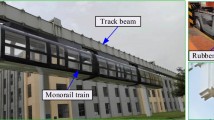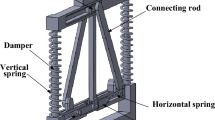Abstract
Damping is known to have a considerable influence on the dynamic behavior of bridges. The fixed damping ratios recommended in design codes do not necessarily represent the complicated damping characteristics of bridge structures. This study investigated the application of stress-dependent damping associated with vehicle-bridge coupling vibration and based on that investigation proposed the stress-dependent damping ratio. The results of the investigation show that the stress-dependent damping ratio is significantly different from the constant damping ratio (5%) defined in the standard specification. When vehicles travel at speeds of 30, 60, and 90, the damping ratios of the bridge model are 3.656%, 3.658%, and 3.671%, respectively. The peak accelerations using the regular damping ratio are 18.9%, 21.3%, and 14.5% of the stress-dependent damping ratio, respectively. When the vehicle load on the bridge is doubled, the peak acceleration of the mid-span node increases by 5.4 times, and the stress-related damping ratio increases by 2.1%. A corrugated steel-web bridge is being used as a case study, and the vibration response of the bridge is compared with the measured results. The acceleration response of the bridge which was calculated using the stress-dependent damping ratio is significantly closer to the measured acceleration response than that using the regular damping ratio.
Similar content being viewed by others
References
Paultre P, Chaallal O, Proulx J. Bridge dynamics and dynamic amplification factors—A review of analytical and experimental findings. Canadian Journal of Civil Engineering, 1992, 19(2): 260–278
Khan E, Lobo J A, Linzell D G. Live load distribution and dynamic amplification on a curved prestressed concrete transit rail bridge. Journal of Bridge Engineering, 2018, 23(6): 04018029
Broquet C, Bailey S F, Fafard M, Brühwiler E. Dynamic behavior of deck slabs of concrete road bridges. Journal of Bridge Engineering, 2004, 9(2): 137–146
Deng L, Yu Y, Zou Q, Cai C S. State-of-the-art review of dynamic impact factors of highway bridges. Journal of Bridge Engineering, 2015, 20(5): 04014080
Yang Y B, Wang Z L, Shi K, Xu H, Yang J P. Adaptive amplifier for a test vehicle moving over bridges: Theoretical study. International Journal of Structural Stability and Dynamics, 2021, 21(3): 2150042
Abdel Raheem S E. Dynamic characteristics of hybrid tower of cable-stayed bridges. Steel and Composite Structures, 2014, 17(6): 803–824
Mashhadi J, Saffari H. Effects of damping ratio on dynamic increase factor in progressive collapse. Steel and Composite Structures, 2016, 22(3): 677–690
Zhang H D, Wang J, Zhang X, Liu G. Effects of viscous damping models on a single-layer latticed dome during earthquakes. Structural Engineering and Mechanics, 2017, 62(4): 455–464
Fujino Y, Kimura K, Tanaka H. Wind Resistant Design of Bridges in Japan: Developments and Practices. Berlin: Springer Science & Business Media, 2012
Barker R M, Puckett J A. Design of Highway Bridges: An LRFD Approach. New Jersey: John Wiley & Sons, 2013
Alipour A, Shafei B, Shinozuka M. Performance evaluation of deteriorating highway bridges located in high seismic areas. Journal of Bridge Engineering, 2011, 16(5): 597–611
Code P. Eurocode 8: Design of Structures for Earthquake Resistance. Brussels: European Committee for Standardization, 2001
Caltrans S D C. Caltrans Seismic Design Criteria. Version 1.6. Sacramento, CA: California Department of Transportation, 2010
Green R. Dynamic response of bridge superstructures-Ontario observations. In: Proceeding of a Symposium of Dynamic Behavior of Bridges at the Transport and Road Research Laboratory. Crowthorne: Transport and Road Research Laboratory (TRRL), 1977
Billing J R. Dynamic loading and testing of bridges in Ontario. Canadian Journal of Civil Engineering, 1984, 11(4): 833–843
Li P F, Wang Y F, Liu B D, Su L. Damping properties of highway bridges in China. Journal of Bridge Engineering, 2014, 19(5): 04014005
Casas J R. Full-scale dynamic testing of the Alamillo cable-stayed bridge in Sevilla (Spain). Earthquake Engineering & Structural Dynamics, 1995, 24(1): 35–51
Myrvoll F, Kaynia A M, Hjorth-Hansen E, Strømmen E. Full-scale dynamic performance testing of the bridge structure and the special cable friction dampers on the cable-stayed Uddevalla bridge. In: Proceeding of 20th IMAC Conference on Structural Dynamics, Los Angeles: SPIE Press, 2002
Magalhães F, Cunha Á, Caetano E, Brincker R. Damping estimation using free decays and ambient vibration tests. Mechanical Systems and Signal Processing, 2010, 24(5): 1274–1290
Rebelo C, Simöes da Silva L, Rigueiro C, Pircher M. Dynamic behavior of twin single-span ballasted railway viaducts—Field measurements and modal identification. Engineering Structures, 2008, 30(9): 2460–2469
Ülker-Kaustell M, Karoumi R. Application of the continuous wavelet transform on the free vibrations of a steel—concrete composite railway bridge. Engineering Structures, 2011, 33(3): 911–919
Ülker-Kaustell M, Karoumi R. Influence of nonlinear stiffness and damping on the train-bridge resonance of a simply supported railway bridge. Engineering Structures, 2012, 41: 350–355
Hart G C, Vasudevan R. Earthquake design of buildings: Damping. Journal of the Structural Division, 1975, 101(1): 11–30
Charney F A. Unintended consequences of modeling damping in structures. Journal of Structural Engineering, 2008, 134(4): 581–592
Eyre R, Tilly G P. Damping measurements on steel and composite bridges. In: Proceeding of a Symposium on Dynamic Behavior of Bridges at the Transport and Road Research Laboratory. Crowthorne: Transport and Road Research Laboratory (TRRL), 1977
Tilly G P. Damping of highway bridges: A review. In: Proceeding of a Symposium on Dynamic Behavior of Bridges at the Transport and Road Research Laboratory. Crowthorne: Transport and Road Research Laboratory (TRRL), 1977
Green M F, Cebon D. Modal testing of two highway bridges. In: Proceeding of 11th International Modal Analysis Conference. Kissimme (FL): Society for Experimental Mechanics, 1993
Hou J L, Xu W B, Chen Y J, Zhang K, Sun H, Li Y. Typical diseases of a long-span concrete-filled steel tubular arch bridge and their effects on vehicle-induced dynamic response. Frontiers of Structural and Civil Engineering, 2020, 14(4): 867–887
Sun Z. Moving-inertial-loads-induced dynamic instability for slender beams considering parametric resonances. Journal of Vibration and Acoustics, 2016, 138(1): 011014
Jin Z, Huang B, Pei S, Zhang Y. Energy-based additional damping on bridges to account for vehicle-bridge interaction. Engineering Structures, 2021, 229: 111637
Glatz B, Fink J. A redesigned approach to the additional damping method in the dynamic analysis of simply supported railway bridges. Engineering Structures, 2021, 241: 112415
Stoura C D, Dimitrakopoulos E G. Additional damping effect on bridges because of vehicle-bridge interaction. Journal of Sound and Vibration, 2020, 476: 115294
Lazan B J. Damping of Materials and Members in Structural Mechanics. Oxford: Pergamon Press, 1968
Wang Y F, Pan Y H, Wen J, Su L. Material damping evaluation of frames made of different materials. Materials Research Innovations, 2014, 18(sup3): 53–58
Kume Y, Hashimoto F, Maeda S. Material damping of cantilever beams. Journal of Sound and Vibration, 1982, 80(1): 1–10
Gounaris G D, Anifantis N K. Structural damping determination by finite element approach. Computers & Structures, 1999, 73(1–5): 445–452
Gounaris G D, Antonakakis E, Papadopoulos C A. Hysteretic damping of structures vibrating at resonance: An iterative complex eigensolution method based on damping-stress relation. Computers & Structures, 2007, 85(23–24): 1858–1868
Mei S Q, Su L, Li P F, Wang Y. Material damping of concrete under cyclic axial compression. Journal of Materials in Civil Engineering, 2018, 30(3): 04017295
Su L, Wang Y F, Li P F, Mei S, Guo K. Seismic analysis of bridges based on stress-dependent damping. Structural Engineering and Mechanics, 2017, 62(3): 281–289
Acknowledgements
This work was supported by the Open Project of National Engineering Laboratory of Bridge Structure Safety Technology of China (No. 2020-GJKFKT-7), the Fundamental Research Funds for Central Research Institutes and Public Service Special Operations of China (No. 2021-9083a), the Key-Area Research and Development Program of Guangdong Province of China (No. 2019B111106002) and the Fundamental Research Funds for Central Research Institutes and Public Service Special Operations of China (No. 2021-9015b).
Author information
Authors and Affiliations
Corresponding author
Rights and permissions
About this article
Cite this article
Li, P., Zhang, J., Mei, S. et al. Numerical analysis of vehicle-bridge coupling vibration concerning nonlinear stress-dependent damping. Front. Struct. Civ. Eng. 16, 239–249 (2022). https://doi.org/10.1007/s11709-021-0804-y
Received:
Accepted:
Published:
Issue Date:
DOI: https://doi.org/10.1007/s11709-021-0804-y




